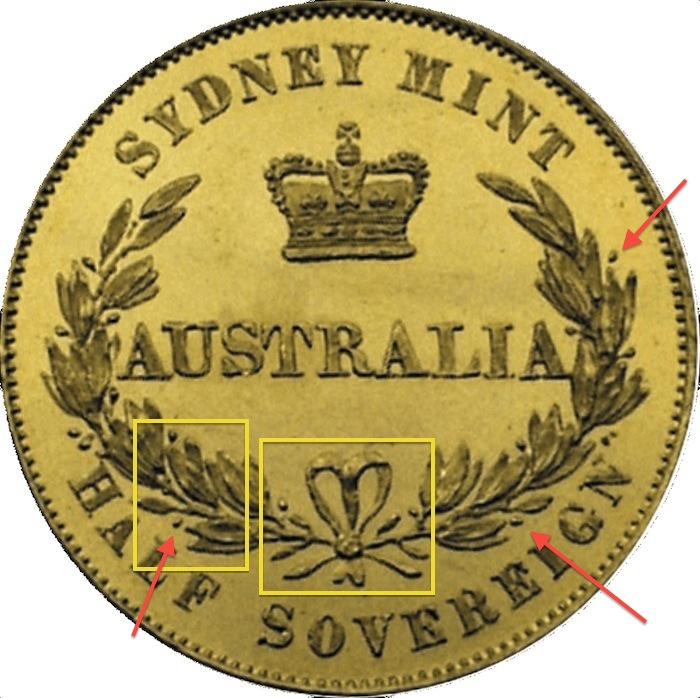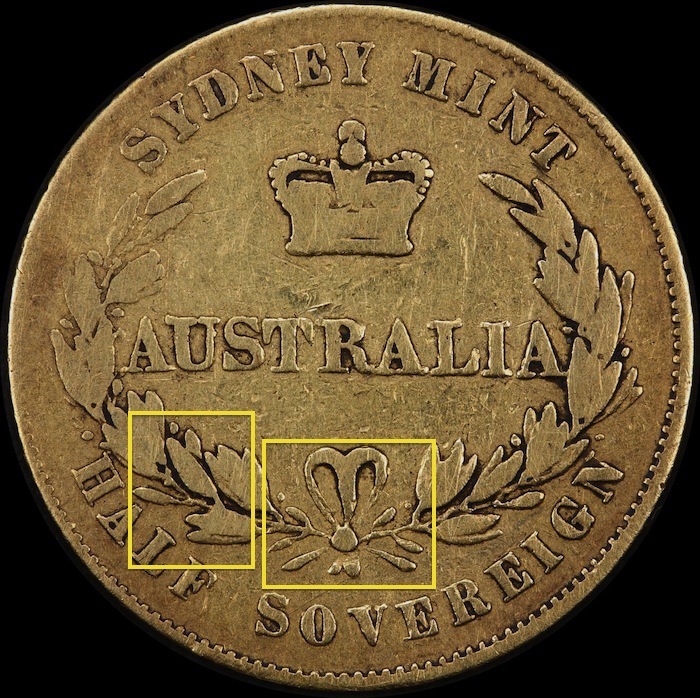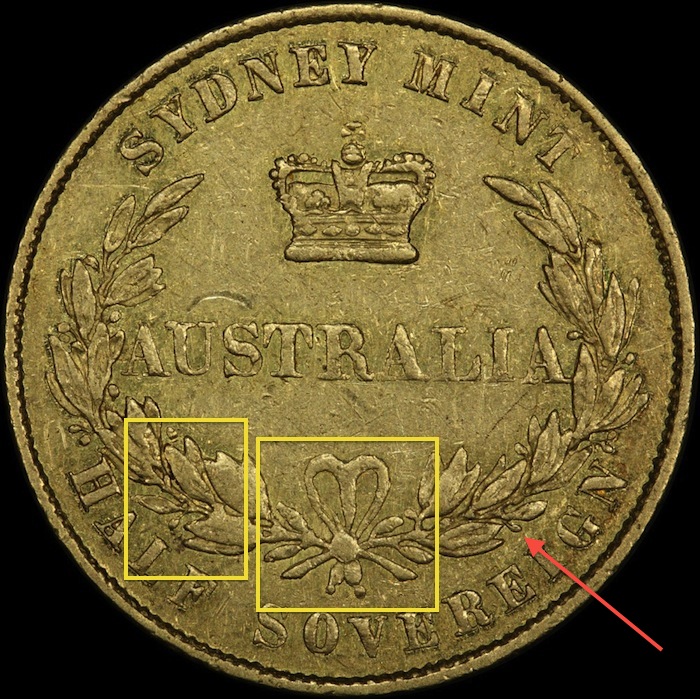The 1856 Sydney Half Sovereign With The Type 2 Reverse - Accident or Design

For many years, the 1856 Sydney half sovereign with the Type 2 reverse was believed to be unique within the Australian gold coin series - no other circulating Australian half sovereign was known with this exact reverse design.
That position has since changed, but the coin remains extremely rare in any condition - the current PCGS population report shows that just 4 examples have been authenticated by them prior to April 2023. Meanwhile, research as at May 2013 indicated that, at that time, no more than 6 unique examples of these coins were known to be available to collectors.
Declared to be the 1853 Pattern Reverse
Until the auction of the Reserve Bank of Australia's physical gold holdings in 2005, the reverse die from which it was struck was thought to have been produced by the same matrix used to strike the 1853 Sydney Mint pattern half sovereign - one of the most important coins in Australia's numismatic history.
News regarding the importance of this coin was first published in an auction catalogue conducted by Spink Australia in November 1981, information confirming that it was struck from a distinct reverse die to both the 1853 pattern and all other Sydney Mint half sovereigns was published in the Pocket Guide to Australian Coins and Banknotes in 2005.
Accident or Design?
As experienced collectors know, design differences that are apparently quite minor can be explained by very significant numismatic or economic events. Just how this particular reverse design came to be on a tiny number of half sovereigns is not yet completely clear, however the theory that has been proposed to date can be summarised by two words - accident or design.
The following extract from correspondence betweeen the Deputy Master of the Sydney Mint (Captain Edward Wolstanholme Ward) and the Master of the Royal Mint in London (Sir John Herschel) certainly provides some context:
"Sir. I have the honour to call your attention to the faulty execution of many of the first supply of dies for the Sydney Mint Coins. The lettering on the dies is defective, especially on the reverse of the half-sovereign, where some letters are punched deeper than others
and they also differ visibly in size. Some of the dies have not the impression in the centre and if used for striking coins, produce a defective stamp Some dies are concave, or become so soon after use, perhaps from the difference of hardness in the interiors as compared with the exterior or rim.
I have thought it right to bring these defects thus prominently before you at once and to direct your attention to them, that no plausible grounds for complaints may be given to the colony respecting the efficient provision of proper material for the execution of a good and proper coin." (AONSW 3/1662, p. 326-7, Ward to Master of the Mint,
18 September 1855, R79/56)
Current thought is that the 1856 half sovereigns with the Type 2 reverse were struck by one "working" reverse half sovereign die that was engraved when the Royal Mint was preparing for the establishment of the Sydney Mint. At some stage in 1853, the Royal Mint struck just four pattern half sovereigns (as well as four sovereigns) for the Sydney Mint. Not four million, nor 4 hundred thousand - just four coins. The 1853 pattern half sovereigns (and sovereigns) are the very first official coins designed for production in Australia, and are regarded as being among the most important coins in Australia's entire numismatic history.
The following is the description of the "discovery" coin (the first to be published in writing), when it appeared as lot 1045 in the Spink Noble Numismatics Auction 39, held between July 8th and 10th in 1992:
Lot 1045: Queen Victoria, Sydney Mint, half sovereign, 1856, first type with plain filleted head of Victoria to the left,. Dies by James Wyon.
This is a remarkable and unique coin that could be classed as a pattern as the reverse die is the identical die used for the 1853 pattern at the Royal Mint in London. The difference from the matrix used for currency coinage from 1855 is mainly in the shape of the wreath, ribbon and crown. Evidently at least one working die must have been prepared from the 1853 pattern matrix and was sent to Sydney for examination and possible use. Since the die has been found muled with an 1856 die and not 1855 it could be concluded that the Mint was short of working dies on a particular day and this, the pattern die, was used.
The 1853 Sydney Mint Pattern Sovereign And Half Sovereign
Four pairs of pattern sovereigns and half sovereigns dated 1853 were struck by the Royal Mint in London for the Sydney Mint, apparently to test the suitability of the proposed designs for coining in the Sydney Mint from 1855. These are the very first official gold coins struck for Australia, and are of the highest numismatic and historic importance.
Only one of these pairs are in private hands - the Royal Mint Museum retains two pairs in their archives, while the British Museum holds one, acquired from the Royal Mint. Just one pair of 1853 pattern sovereign and half sovereign are in private hands. In their most recent public sale, in the 2009 auction of the Quartermaster Collection of Australian gold coins, they sold for in excess of A$1,100,000.
The exact date of the production of the 1853 patterns is not yet clear - what is known is that the first formal approval for a branch of the Royal Mint to be established at Sydney was a British Treasury minute issued on March 22nd, 1853, and that an Order in Council "… dated 18 October 1854, had defined the design of sovereigns and half sovereigns …"
From the above archival records, we can clearly see that the 1853 pattern gold coins were struck well before official approval for the final designs of the Sydney Mint's gold coinage had been given. It is not difficult to imagine the role that these coins must have played in the genesis of Australia's first official gold coins - it is not inconceivable to think that they would have been viewed, examined and discussed by members of the Royal Family, as well as at the highest levels of government in both Britain and Australia, in diplomatic circles and by senior figures in the arts and commercial communities.

A. A berry is visible outside the wreath at around 2 o'clock;
B. A berry is visible between the wreath and "I" at 4 30;
C. A berry is visible between the wreath and "L" at 7 o'clock.
As has been stated, prior to 2005, the reverse die from which it was struck was thought to have been produced by the same matrix used to strike the 1853 Sydney Mint pattern half sovereign. Research conducted by Barrie Winsor in preparation for the auction of gold coins taken from the Reserve Bank's archives showed determined that what is know referred to as the "Type 2" Sydney Mint half sovereign reverse differed from the 1853 pattern reverse in several minor, but important ways:

A. Berries noted at points A, B and C on the reverse of the 1853 pattern half sovereign are missing;
B. The wreath branches near the ribbon are thin;
C. The tips of the ribbon below the knot are thin.

The standard reverse seen on the Sydney Mint half sovereigns, now known as the Type 3 reverse, has the following characteristics:
A. A berry is visible between the wreath and "L" at 7 o'clock;
B. The tips of the ribbon below the knot are thick;
C. The wreath branches near the ribbon are thick;
D. A berry is visible between the wreath and "I" at 4 30.
The Thirteenth Edition of the Pocket Guide to Australian Coins and Banknotes by Greg McDonald, published in November 2005, showed high resolution images of each of the three different reverse designs seen on Sydney Mint half sovereigns.
This is the first time that the Type 2 reverse was formally acknowledged as being distinct from both the 1853 pattern reverse and the standard Sydney Mint reverse. The catalogue for the auction of the Reserve Bank of Australia's archives was published in the same month - three circulated examples of this rare and historic coin were included in that sale.
One logical explanation for the existence of 1856 half sovereigns with the Type 2 reverse are that a "pattern" half sovereign reverse die (i.e. one that was different to the die used to strike the 1853 patterns, and also different to those used to strike coins for circulation) was somehow unintentionally mixed with a batch of "working" half sovereign dies sent from London, and that therefore it was used quite by accident. A more pragmatic thought is that the Sydney Mint may have been short of half sovereign reverse dies at some stage during 1856, and that the pattern die was deployed into the production process out of necessity.
Numismatic study of Sydney Mint half sovereigns has shown that Mint staff exercised initiative on numerous occasions between 1855 and 1866 - overdates and altered legends are far more numerous in this period than they are at any other time in the history of Australian gold coinage. That the 1856 half sovereign with the Type 2 reverse was struck from pattern dies is beyond dispute, whether you believe this came about by accident or design depends on your view of the organisational culture and working conditions at the Sydney Mint during these formative years.
If we consider that the 1856 half sovereign with the Type 2 reverse is a distinct "type" to the 1855 half sovereign and the 1856 half sovereign with the Type 3 reverse, when we also consider that the known population of this coin is around 12 examples, it is most likely among the rarest gold "type" coins in the entire Australian gold coin series.